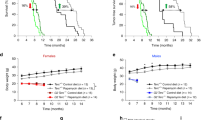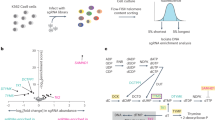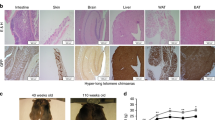Abstract
Accumulation of short telomeres is a hallmark of aging. Mutations in telomerase or telomere-binding proteins lead to telomere shortening or dysfunction and are at the origin of human pathologies known as ‘telomere syndromes’, which are characterized by loss of the regenerative capacity of tissues and fibrotic pathologies. Here, we generated two mouse models of kidney fibrosis, either by combining telomerase deficiency to induce telomere shortening and a low dose of folic acid, or by conditionally deleting Trf1, a component of the shelterin telomere protective complex, from the kidneys. We find that short telomeres sensitize the kidneys to develop fibrosis in response to folic acid and exacerbate the epithelial-to-mesenchymal transition (EMT) program. Trf1 deletion in kidneys led to fibrosis and EMT activation. Our findings suggest that telomere shortening or dysfunction may contribute to pathological, age-associated renal fibrosis by influencing the EMT program.
This is a preview of subscription content, access via your institution
Access options
Access Nature and 54 other Nature Portfolio journals
Get Nature+, our best-value online-access subscription
$29.99 / 30 days
cancel any time
Subscribe to this journal
Receive 12 digital issues and online access to articles
$119.00 per year
only $9.92 per issue
Buy this article
- Purchase on Springer Link
- Instant access to full article PDF
Prices may be subject to local taxes which are calculated during checkout








Similar content being viewed by others
Data availability
RNA-seq data have been deposited in the National Center for Biotechnology Information’s Gene Expression Omnibus under accession GSE162447 (subseries GSE162445 and GSE162446). The Molecular Signatures database used in the study is available at https://www.gsea-msigdb.org/gsea/msigdb/. All other data supporting the findings of this study are available from the corresponding author upon request.
References
Luyckx, V. A., Tonelli, M. & Stanifer, J. W. The global burden of kidney disease and the sustainable development goals. Bull. World Health Organ. 96, 414–422C (2018).
Humphreys, B. D. Mechanisms of renal fibrosis. Annu. Rev. Physiol. 80, 309–326 (2018).
Dongre, A. & Weinberg, R. A. New insights into the mechanisms of epithelial–mesenchymal transition and implications for cancer. Nat. Rev. Mol. Cell Biol. 20, 69–84 (2019).
Grande, M. T. et al. Snail1-induced partial epithelial-to-mesenchymal transition drives renal fibrosis in mice and can be targeted to reverse established disease. Nat. Med. 21, 989–997 (2015).
Inoue, T., Okada, H., Takenaka, T., Watanabe, Y. & Suzuki, H. A case report suggesting the occurrence of epithelial–mesenchymal transition in obstructive nephropathy. Clin. Exp. Nephrol. 13, 385–388 (2009).
Martinez, P. & Blasco, M. A. Telomere-driven diseases and telomere-targeting therapies. J. Cell Biol. 216, 875–887 (2017).
de Lange, T. Shelterin-mediated telomere protection. Annu. Rev. Genet. 52, 223–247 (2018).
Armanios, M. & Blackburn, E. H. The telomere syndromes. Nat. Rev. Genet. 13, 693–704 (2012).
Blackburn, E. H. Telomere states and cell fates. Nature 408, 53–56 (2000).
Blasco, M. A. Telomeres and human disease: ageing, cancer and beyond. Nat. Rev. Genet. 6, 611–622 (2005).
IJpma, A. S. & Greider, C. W. Short telomeres induce a DNA damage response in Saccharomyces cerevisiae. Mol. Biol. Cell 14, 987–1001 (2003).
Blasco, M. A., Funk, W., Villeponteau, B. & Greider, C. W. Functional characterization and developmental regulation of mouse telomerase RNA. Science 269, 1267–1270 (1995).
Flores, I., Cayuela, M. L. & Blasco, M. A. Effects of telomerase and telomere length on epidermal stem cell behavior. Science 309, 1253–1256 (2005).
Lopez-Otin, C., Blasco, M. A., Partridge, L., Serrano, M. & Kroemer, G. The hallmarks of aging. Cell 153, 1194–1217 (2013).
Armanios, M. Y. et al. Telomerase mutations in families with idiopathic pulmonary fibrosis. N. Engl. J. Med. 356, 1317–1326 (2007).
Armanios, M. Telomerase mutations and the pulmonary fibrosis–bone marrow failure syndrome complex. N. Engl. J. Med. 367, 384 (2012).
Mitchell, J. R., Wood, E. & Collins, K. A telomerase component is defective in the human disease dyskeratosis congenita. Nature 402, 551–555 (1999).
Tsakiri, K. D. et al. Adult-onset pulmonary fibrosis caused by mutations in telomerase. Proc. Natl Acad. Sci. USA 104, 7552–7557 (2007).
Coresh, J., Astor, B. C., Greene, T., Eknoyan, G. & Levey, A. S. Prevalence of chronic kidney disease and decreased kidney function in the adult US population: Third National Health and Nutrition Examination Survey. Am. J. Kidney Dis. 41, 1–12 (2003).
Beier, F., Foronda, M., Martinez, P. & Blasco, M. A. Conditional TRF1 knockout in the hematopoietic compartment leads to bone marrow failure and recapitulates clinical features of dyskeratosis congenita. Blood 120, 2990–3000 (2012).
Bar, C. et al. Telomerase gene therapy rescues telomere length, bone marrow aplasia and survival in mice with aplastic anemia. Blood 127, 1770–1779 (2016).
Povedano, J. M., Martinez, P., Flores, J. M., Mulero, F. & Blasco, M. A. Mice with pulmonary fibrosis driven by telomere dysfunction. Cell Rep. 12, 286–299 (2015).
Povedano, J. M. et al. Therapeutic effects of telomerase in mice with pulmonary fibrosis induced by damage to the lungs and short telomeres. eLife 7, e31299 (2018).
Blasco, M. A. et al. Telomere shortening and tumor formation by mouse cells lacking telomerase RNA. Cell 91, 25–34 (1997).
Lee, H. W. et al. Essential role of mouse telomerase in highly proliferative organs. Nature 392, 569–574 (1998).
Herrera, E. et al. Disease states associated with telomerase deficiency appear earlier in mice with short telomeres. EMBO J. 18, 2950–2960 (1999).
Bajwa, A. et al. Sphingosine kinase 2 deficiency attenuates kidney fibrosis via IFN-γ. J. Am. Soc. Nephrol. 28, 1145–1161 (2017).
Yang, B. et al. PHF14: an innate inhibitor against the progression of renal fibrosis following folic acid-induced kidney injury. Sci. Rep. 7, 39888 (2017).
Long, D. A., Woolf, A. S., Suda, T. & Yuan, H. T. Increased renal angiopoietin-1 expression in folic acid-induced nephrotoxicity in mice. J. Am. Soc. Nephrol. 12, 2721–2731 (2001).
Damera, S. et al. Serum alkaline phosphatase levels associate with elevated serum C-reactive protein in chronic kidney disease. Kidney Int. 79, 228–233 (2011).
Leibovitch, I., Ben-Chaim, J., Ramon, J. & Goldwasser, B. Increased serum alkaline phosphatase activity: a possible indicator of renal damage. J. Clin. Lab. Anal. 5, 406–409 (1991).
Collen, M. J., Ansher, A. F., Chapman, A. B., Mackow, R. C. & Lewis, J. H. Serum amylase in patients with renal insufficiency and renal failure. Am. J. Gastroenterol. 85, 1377–1380 (1990).
Moyses-Neto, M. et al. Acute renal failure and hypercalcemia. Ren. Fail. 28, 153–159 (2006).
Barreto, F. C., Barreto, D. V., Massy, Z. A. & Drueke, T. B. Strategies for phosphate control in patients with CKD. Kidney Int. Rep. 4, 1043–1056 (2019).
Cole, N. I. et al. Serum sodium concentration and the progression of established chronic kidney disease. J. Nephrol. 32, 259–264 (2019).
Korgaonkar, S. et al. Serum potassium and outcomes in CKD: insights from the RRI-CKD cohort study. Clin. J. Am. Soc. Nephrol. 5, 762–769 (2010).
Yang, H.-C., Zuo, Y. & Fogo, A. B. Models of chronic kidney disease. Drug Discov. Today Dis. Models 7, 13–19 (2010).
Kalluri, R. & Neilson, E. G. Epithelial–mesenchymal transition and its implications for fibrosis. J. Clin. Invest. 112, 1776–1784 (2003).
Blasco, M. A. Telomere length, stem cells and aging. Nat. Chem. Biol. 3, 640–649 (2007).
d’Adda di Fagagna, F. et al. A DNA damage checkpoint response in telomere-initiated senescence. Nature 426, 194–198 (2003).
Gonzalez-Suarez, E., Samper, E., Flores, J. M. & Blasco, M. A. Telomerase-deficient mice with short telomeres are resistant to skin tumorigenesis. Nat. Genet. 26, 114–117 (2000).
Han, W. K., Bailly, V., Abichandani, R., Thadhani, R. & Bonventre, J. V. Kidney injury molecule-1 (KIM-1): a novel biomarker for human renal proximal tubule injury. Kidney Int. 62, 237–244 (2002).
Humphreys, B. D. et al. Chronic epithelial kidney injury molecule-1 expression causes murine kidney fibrosis. J. Clin. Invest. 123, 4023–4035 (2013).
Nickolas, T. L. et al. Sensitivity and specificity of a single emergency department measurement of urinary neutrophil gelatinase-associated lipocalin for diagnosing acute kidney injury. Ann. Intern. Med. 148, 810–819 (2008).
Stemmler, M. P., Eccles, R. L., Brabletz, S. & Brabletz, T. Non-redundant functions of EMT transcription factors. Nat. Cell Biol. 21, 102–112 (2019).
Lovisa, S. et al. Epithelial-to-mesenchymal transition induces cell cycle arrest and parenchymal damage in renal fibrosis. Nat. Med. 21, 998–1009 (2015).
Schietke, R. et al. The lysyl oxidases LOX and LOXL2 are necessary and sufficient to repress E-cadherin in hypoxia: insights into cellular transformation processes mediated by HIF-1. J. Biol. Chem. 285, 6658–6669 (2010).
Reginensi, A. et al. SOX9 controls epithelial branching by activating RET effector genes during kidney development. Hum. Mol. Genet. 20, 1143–1153 (2011).
Lindström, N. O. et al. Progressive recruitment of mesenchymal progenitors reveals a time-dependent process of cell fate acquisition in mouse and human nephrogenesis. Dev. Cell 45, 651–660 (2018).
Angelotti, M. L. et al. Characterization of renal progenitors committed toward tubular lineage and their regenerative potential in renal tubular injury. Stem Cells 30, 1714–1725 (2012).
Davies, J. A. et al. Development of an siRNA-based method for repressing specific genes in renal organ culture and its use to show that the Wt1 tumour suppressor is required for nephron differentiation. Hum. Mol. Genet. 13, 235–246 (2004).
Rothenpieler, U. W. & Dressler, G. R. Pax-2 is required for mesenchyme-to-epithelium conversion during kidney development. Development 119, 711–720 (1993).
Huang, B. et al. Wt1 and Pax2 re-expression is required for epithelial–mesenchymal transition in 5/6 nephrectomized rats and cultured kidney tubular epithelial cells. Cells Tissues Organs 195, 296–312 (2012).
Ma, Y. et al. Cloning and characterization of two promoters for the human HSAL2 gene and their transcriptional repression by the Wilms’ tumor suppressor gene product. J. Biol. Chem. 276, 48223–48230 (2001).
Xu, Y. & Sun, Z. Molecular basis of Klotho: from gene to function in aging. Endocr. Rev. 36, 174–193 (2015).
Vera, E., Bernardes de Jesus, B., Foronda, M., Flores, J. M. & Blasco, M. A. Telomerase reverse transcriptase synergizes with calorie restriction to increase health span and extend mouse longevity. PLoS ONE 8, e53760 (2013).
Bielesz, B. et al. Epithelial Notch signaling regulates interstitial fibrosis development in the kidneys of mice and humans. J. Clin. Invest. 120, 4040–4054 (2010).
Edeling, M., Ragi, G., Huang, S., Pavenstädt, H. & Susztak, K. Developmental signalling pathways in renal fibrosis: the roles of Notch, Wnt and Hedgehog. Nat. Rev. Nephrol. 12, 426–439 (2016).
Huang, S. et al. Jagged1/Notch2 controls kidney fibrosis via Tfam-mediated metabolic reprogramming. PLoS Biol. 16, e2005233 (2018).
Bejarano, L. et al. Safety of whole-body abrogation of the TRF1 shelterin protein in wild-type and cancer-prone mouse models. iScience 19, 572–585 (2019).
Greider, C. W. & Blackburn, E. H. The telomere terminal transferase of Tetrahymena is a ribonucleoprotein enzyme with two kinds of primer specificity. Cell 51, 887–898 (1987).
Fazilaty, H. et al. A gene regulatory network to control EMT programs in development and disease. Nat. Commun. 10, 5115 (2019).
Liu, Y. et al. The telomerase reverse transcriptase is limiting and necessary for telomerase function in vivo. Curr. Biol. 10, 1459–1462 (2000).
Martínez, P. et al. Increased telomere fragility and fusions resulting from TRF1 deficiency lead to degenerative pathologies and increased cancer in mice. Genes Dev. 23, 2060–2075 (2009).
Ruzankina, Y. et al. Deletion of the developmentally essential gene ATR in adult mice leads to age-related phenotypes and stem cell loss. Cell Stem Cell 1, 113–126 (2007).
Terryn, S. et al. A primary culture of mouse proximal tubular cells, established on collagen-coated membranes. Am. J. Physiol. Renal Physiol. 293, F476–F485 (2007).
Graña, O., Rubio-Camarillo, M., Fdez-Riverola, F., Pisano, D. G. & Glez-Peña, D. Nextpresso: next-generation sequencing expression analysis pipeline. Curr. Bioinform. 13, 583–591 (2017).
Trapnell, C. et al. Differential gene and transcript expression analysis of RNA-seq experiments with TopHat and Cufflinks. Nat. Protoc. 7, 562–578 (2012).
Langmead, B., Trapnell, C., Pop, M. & Salzberg, S. L. Ultrafast and memory-efficient alignment of short DNA sequences to the human genome. Genome Biol. 10, R25 (2009).
Li, H. et al. The Sequence Alignment/Map format and SAMtools. Bioinformatics 25, 2078–2079 (2009).
Anders, S., Pyl, P. T. & Huber, W. HTSeq—a Python framework to work with high-throughput sequencing data. Bioinformatics 31, 166–169 (2015).
Subramanian, A. et al. Gene-set enrichment analysis: a knowledge-based approach for interpreting genome-wide expression profiles. Proc. Natl Acad. Sci. USA 102, 15545–15550 (2005).
Acknowledgements
Research in the Blasco laboratory is funded by the Spanish State Research Agency, Ministry of Science and Innovation, cofounded by the European Regional Development Fund (AF2017-82623-R and SAF2015-72455-EXP), the Comunidad de Madrid Project (S2017/BMD-3770), the World Cancer Research Project (16-1177), the European Research Council (SHELTERINS GA882385) and the Fundación Botín (Spain).
Author information
Authors and Affiliations
Contributions
M.A.B. secured funding and conceived the original idea, designed and interpreted results, and wrote the paper. P.M. designed and interpreted results and contributed to writing the paper. S.S. designed, performed and interpreted experiments and contributed to writing the paper. O.G.-C. analyzed the RNA-seq data.
Corresponding author
Ethics declarations
Competing interests
The authors declare no competing interests.
Additional information
Peer review information Nature Aging thanks Zhaoyong Hu and the other, anonymous, reviewer(s) for their contribution to the peer review of this work.
Publisher’s note Springer Nature remains neutral with regard to jurisdictional claims in published maps and institutional affiliations.
Supplementary information
Extended Data Fig. 1 Telomerase-deficient mice with short telomeres do not spontaneously develop renal fibrosis.
a, Scheme of the experimental approach. b-f, Representative images and quantification of Masson trichrome (b), Sirius Red (c), PAS-Diastase (d), SMA (e) and E-cadherin (f) in Tert+/+ and G3Tert−/− mice. g-h, Representative images and quantification of p21 (g) and CC3 (h) immunohistochemistry stainings in Tert+/+ and G3Tert−/− mice. Insets show amplified images. A t-test two tailed was used for statistical analysis. Data is presented as mean values +/- SEM. The number of mice analyzed per genotype is indicated.
Extended Data Fig. 2 Blood parameters.
Blood creatinine (a) and blood urea nitrogen (BUN) (b) levels of untreated and FA treated Tert+/+ and G3Tert−/− mice. Blood samples were collected at days 2, 7 and 14. Mice were sacrificed at day 14. a, Two-way Anova with post hoc Bonferroni test was used for statistical analysis. Data is presented as mean values +/- SEM. The number of mice analyzed per genotype is indicated. *p ≤ 0.05; **p ≤ 0.01; ***p ≤ 0.001.
Extended Data Fig. 3 Effect of short telomeres on cell cycle regulators.
Relative expression of CCnd1, CCnd2, CCnb1 and CCne1 in Tert+/+, FA-treated Tert+/+, G3Tert−/− and FA-treated G3Tert−/− mice 14 days after administration of a low dose of FA. One-way Anova was used for statistical analysis. Data is presented as mean values +/- SEM. The number of mice analyzed per genotype is indicated. *p ≤ 0.05; **p ≤ 0.01; ***p ≤ 0.001.
Extended Data Fig. 4 Effect of shorter telomeres on EMT related genes.
a, Gene expression data obtained by RNA-seq of kidney samples from 7- and 47-week old Terc+/+ and G3 Tert−/− mice. b, Gene Set Enrichment Analysis (GSEA) plots for the EMT pathway. False Discovery Rates (FDR) are indicated. Samples correspond to kidneys of five independent Tert+/+, G3 Tert−/− mice.
Extended Data Fig. 5 Effect of shorter telomeres on nephric‐progenitor genes.
a, Relative expression of Sox-9, Wt-1, Pax-2, Sall2, Acvr2b, Klotho in in Tert+/+, FA-treated Tert+/+, G3Tert−/− and FA-treated G3Tert−/− mice 14 days after administration of a low dose of FA. b, Representative images and quantification of Sox-9 immunohistochemistry staining. The insets show amplified images. One-way Anova was used for statistical analysis. One-way Anova was used for statistical analysis. Data is presented as mean values +/- SEM. The number of mice analyzed per genotype is indicated. *p ≤ 0.05; **p ≤ 0.01; ***p ≤ 0.001
Extended Data Fig. 6 Effect of shorter telomeres on Notch-targeted genes.
Relative expression of Notch1, 2, 3, Jagged1 and Tfam in Tert+/+, FA-treated Tert+/+, G3Tert−/− and FA-treated G3Tert−/− mice 14 days after administration of a low dose of FA. One-way Anova was used for statistical analysis. Data is presented as mean values +/- SEM. The number of mice analyzed per genotype is indicated. *p ≤ 0.05; **p ≤ 0.01; ***p ≤ 0.001.
Extended Data Fig. 7 TERT activation rescued the EMT phenotype in vitro.
a,b, Microscopic bright field images of proximal tubule cell (PTC) culture at day 8 (a) and day 14 post-transduction with either the empty or the mTert containing vector (b). c, Representative images of Immunofluorescence for E-Cadherin, SMA and Tgfβ1. Twenty micrographs were captured from each condition.
Supplementary information
Supplementary Information
Supplementary Tables 1 and 2.
Rights and permissions
About this article
Cite this article
Saraswati, S., Martínez, P., Graña-Castro, O. et al. Short and dysfunctional telomeres sensitize the kidneys to develop fibrosis. Nat Aging 1, 269–283 (2021). https://doi.org/10.1038/s43587-021-00040-8
Received:
Accepted:
Published:
Issue Date:
DOI: https://doi.org/10.1038/s43587-021-00040-8
This article is cited by
-
Telomere dysfunction in ageing and age-related diseases
Nature Cell Biology (2022)
-
Telomere shortening promotes kidney fibrosis
Nature Reviews Nephrology (2021)
-
The role of telomere dysfunction in genomic instability and age-related diseases
Genome Instability & Disease (2021)



